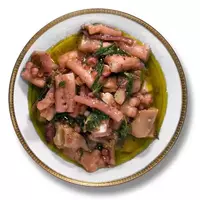Pickled octopuses

Did you know that translated from ancient Greek, the name of the most famous representatives of cephalopods octopus or Octōpoda translates as "eight legs. " It is noteworthy that typical octopuses live sufficiently at great depths in the water column. From the name of octopuses or sprouts, it can be understood that mollusks stand out for their special biological structure.
The body of octopuses has an oval shape. The mollusk is naturally "equipped" with eight tentacles-hands, on which suction cups are located. The uniqueness of octopuses lies in the fact that these cephalopods have three hearts, one of which, most importantly, equips the body with sprouts with blue blood. Due to the absence of spine and bone tissue in the structure of the mollusk, octopuses can easily change their original shape.
This allows the mollusk to pass through openings that reach a diameter of six centimeters. Octopuses can change their original color, thus adapting to the environment. Typically, octopuses live in the seas and oceans of tropical and subtropical climatic zones. Octopuses are predators and feed on smaller molluscs, fish, as well as crustaceans. Some octopus species are considered poisonous and life-threatening to humans.
Octopuses have long been used for culinary purposes. In Japan, for example, octopus meat is considered a staple of everyday diets. Famous takoyaks are made from octopuses, as well as sushi. Exotic for Europeans and familiar to Asians is a dish that is prepared from a still living octopus. Octopus tentacles are cut into small pieces and eaten for several minutes while the muscles of the mollusk continue to contract.
Such a product of pickled octopuses in the global culinary tradition has become widespread. Nowadays, pickled octopuses can be found on the shelves of domestic grocery stores. It is worth noting that pickled octopuses can become not only original, but also a useful treat for people of different ages. Pickled octopuses are especially popular in Mediterranean cuisine.
Pickled octopuses are served to the table as a savoury snack in their own right. In addition, pickled octopuses are ingredients in salads, sea cocktails, soups and seafood-based sauces. Pickled octopuses can be purchased in a store or prepared with your own hand at home.
Of course, it is better to use fresh seafood to make pickled octopuses. However, it is not so easy to find fresh octopuses in our latitudes. Therefore, we offer you a recipe for pickled octopuses made on the basis of frozen seafood. So, to begin with, octopuses are thawed and then peeled, insides and eyes. Octopuses are boiled for 50 minutes.
Cooked octopus tentacles are cut into 2 cm pieces and finely chopped garlic, salt, black pepper, as well as thyme are added. At the final stage of pickled octopuses preparation vegetable oil and vinegar are added to the obtained mass. Octopuses are kept in marinade for about 3 days in refrigerator. I serve pickled octopuses to the table accompanied by wine and fresh bread.
73 kCal pickled octopuses
Energy value of pickled octopuses (Ratio of proteins, fats, carbohydrates - ju):
Proteins: 18.2 g (~ 73 kCal)
Fats: 0 g (~ 0 kCal)
Carbohydrates: 0 g (~ 0 kCal)
Energy ratio (b | y): 100% | 0% | 0%
 Español
Español Français
Français Português
Português Русский
Русский 简体中文
简体中文 繁體中文
繁體中文 日本語
日本語 한국어
한국어 العربية
العربية Türkçe
Türkçe Қазақ
Қазақ Deutsch
Deutsch Italiano
Italiano Українська
Українська
